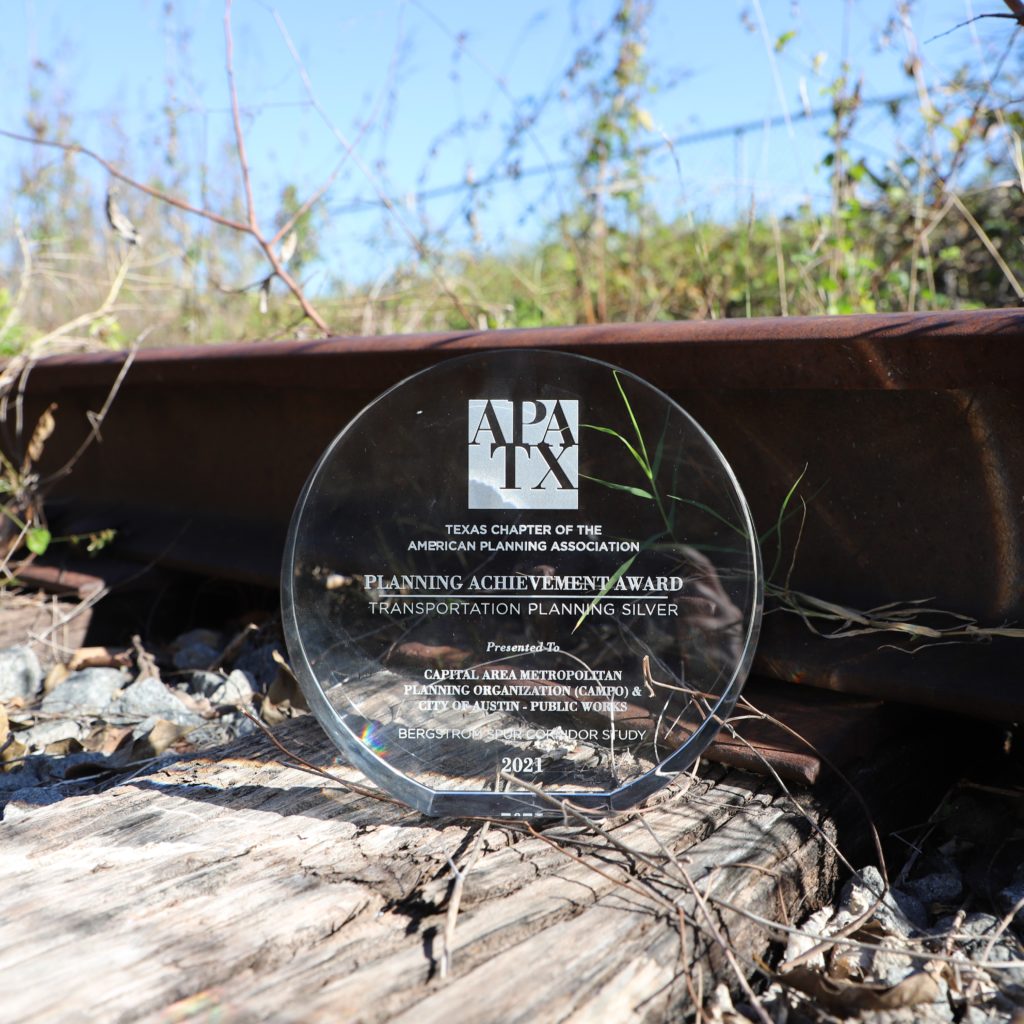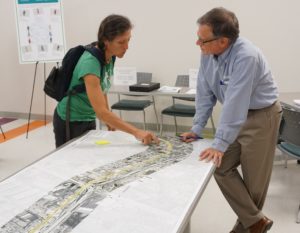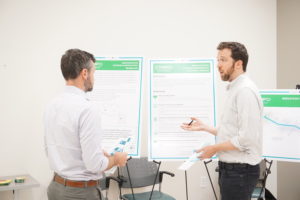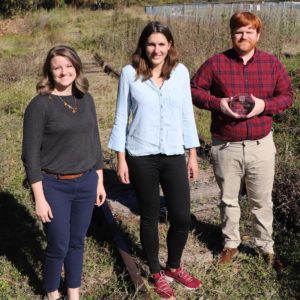Innovative Study Paves the Way for a Car-Free Route in South Austin

The APA-Texas Chapter has chosen the Bergstrom Spur Corridor Study as a recipient of the 2021 Transportation Planning Achievement Award – Silver. It was also featured in the City of Austin’s Urban Trails newsletter. Freese and Nichols works on pedestrian and bike infrastructure all over the state. We are currently designing or implementing 7% of all Transportation Alternative grant funded projects by TxDOT in 2021 for Small and Medium sized Urban areas – in addition to larger projects like the Bergstrom Spur-West urban trail. Read below as we share the study’s innovative approaches, practical results and outstanding service.
Summary
The Bergstrom Spur Corridor Study partnered the Capital Area Metropolitan Planning Organization with the City of Austin Urban Trails Program.
The Bergstrom Spur is an abandoned rail corridor that stretches approximately 6 miles long and averages about 50 feet wide from Vinson Drive in southwest Austin to US 183 near the Austin-Bergstrom International Airport in southeast Austin. This rail line was a critical connection to the former site of the Bergstrom Air Force Base, but when the base was closed in 1993, it was repurposed as an airport, and the Bergstrom Spur railroad corridor was abandoned and is itself now being repurposed as a bicyclist, pedestrian, transit multimodal transportation corridor.
The Bergstrom Spur corridor remains a source of great potential for connectivity through south Austin. In its western segment, the corridor will have a controlled crossing at S. 1st Street and S. Congress Avenue and will connect to the South Congress Transit Center and various small business employment opportunities. In its central segment, the corridor will provide a placeholder for sharing with the transit service and will connect residents, businesses, and services with controlled street crossings and a grade-separated underpass at the I-35 Service Roads. The eastern segment separates transit onto the street network and continues the trail users along Bergstrom Spur, with connections to employment, retail, services, the new Texas Department of Transportation headquarters, and onward to connections with the existing and proposed multimodal networks near the Austin-Bergstrom International Airport.
Planning and Innovation
Historically, the community has turned its back on the railroad corridor, shying away from its noise, vibration, and air quality impacts and most recently from the overgrown and vagrancy effects of its abandonment. The Bergstrom Spur multimodal corridor creates a sense of purpose along and adjacent to the railroad corridor, adding trailheads and celebrating the connections to the clusters of destinations along

the way, as pearls along a string. The provision of a non-motorized east-west passage that runs parallel to US 290/SH 71 opens up connections to employment, retail, and services to those that do not have reliable personal motorized transportation. Concurrently, Bergstrom Spur provides a dedicated place to exercise and recreate in the southern part of Austin that is starting to convert its light industrial nature into a mixed-use pattern of development.
A comprehensive planning approach was utilized to evaluate the potential for the adaptive reuse of vacant and lower valued industrial and commercial uses into much needed higher density residential and supporting uses. One principle which was applied across all planning elements was the consideration of vulnerable populations. A portion of the Austin population is considered vulnerable under the Title VI/Environmental Justice definitions established by the Federal Highway Administration. These laws (Title VI of the Civil Rights Act and Executive Order 12898 on Environmental Justice) forbid discrimination based on race, color, national origin, and minority/low-income status. The Capital Area Metropolitan Planning Organization expands on these characteristics to include others such as school-aged children, seniors, and persons with disabilities. The Bergstrom Spur Corridor Study provides an urban trail facility for all ages and abilities and focuses on community-centered and context-sensitive recommendations. The project has been funded for construction and will benefit an area of the region that has been underserved.
Engagement
Public engagement helped create this well-supported plan that reflects the values of the local community. The public education and participation effort emphasized engaging vulnerable populations by providing outreach in both English and Spanish. The outreach team worked to engage all those interested in the Bergstrom Spur Corridor planning effort and developed a stakeholder list of more than 700 area residents, neighborhood associations, businesses, schools, community groups, and government entities to share information and gather input.

A wide range of activities and tools were used for public involvement to provide convenient opportunities for the public to attend meetings, find information from the convenience of their homes or office, meet the project team out in the community, and receive project updates.
A web page was developed on the Capital Area Metropolitan Planning Organization website to share project information, including a project description, links to virtual open house sand meeting materials, and information on how stakeholders can share comments and input.
Various tools were used to gather input from the public, including surveys available in electronic and printed formats, written comment cards and mapped input. Public engagement was continuously evaluated to improve the effectiveness of outreach efforts. Participants were encouraged to provide input on the efforts, and engagement strategies were modified to reach underrepresented demographic groups. This included coordination with service providers to reach Spanish-speaking communities, as well as mailing information to groups that have lower rates of internet access.
Compatibility

The Bergstrom Spur rail-to-trail project was envisioned as part of the council-adopted Urban Trails Plan and is part of the Capital Area Metropolitan Planning Organization (CAMPO) 2045 Regional Active Transportation Plan; thus, Bergstrom Spur has been part of an extensive public engagement process. Non-motorized transportation has been a central component of the transportation planning for the CAMPO area for neighborhood mobility to employment, services, and recreation. A portion of the Austin population is considered vulnerable. The Bergstrom Spur Corridor Study provides an urban trail facility for all ages and abilities and focuses on community-centered and context-sensitive recommendations.
An environmental site assessment was performed to identify any recognized environmental concerns that may constitute barriers to redevelopment along the corridor, require sensitive consideration, or pose hazards to human health or the environment during construction and then usage of the constructed trails.
Currently, development along the corridor disregards the abandoned railroad corridor and, in some instances has erected walls that separate their development from the Bergstrom Spur. Gradually, development along the corridor will be able to adapt to the new urban trail and transit service provisions along the corridor. Still, special focus should be given to economic development for community development. Given that many of the adjacent neighborhoods include vulnerable populations, future development will provide a variety of job opportunities and amenities that are accessible to the entire community, especially those who are vulnerable.
Effectiveness and Results
During the preparation of the Bergstrom Spur Corridor Study, the “line on a map” that had been the Bergstrom Spur during regional and areawide planning began to take on specific attributes of typical sections along its length, specific locations for trailheads, parklets and connections to the community. Community spirits and expectations were lifted.
Now that funds have been approved for the design and construction of the trails and amenities elements of the Bergstrom Spur, engagement with community leaders and stakeholders to advance the design concepts for trail appearance and amenities is ramping up. Community participation in forming the trail design and amenities will foster localized trail adoption for surveillance and care.
The environmental site assessment performed by the Bergstrom Spur Corridor Study set the stage for the acquisition of the remaining portions of the Bergstrom Spur from Union Pacific. The right-of-way overgrowth and vagrants will be cleared to facilitate a topographic survey of the corridor, which will be a welcome enhancement to the quality of life of the adjacent properties and neighborhoods.
When construction is completed, the Bergstrom Spur project will enhance public health by enabling active transportation that contributes to healthy lifestyles. It also prioritizes safety and accommodates users from diverse backgrounds, ages, abilities and locations.
The implemented trail improves connectivity and mobility by connecting existing housing, jobs, community services and the existing transportation network. It facilitates community mobility as a premier east-west active transportation connection for all ages and abilities in Austin and incorporates opportunities for future transit services and transportation expansion.
The Bergstrom Spur Corridor Study addresses the need to promote environmental and social sustainability as well as catalyze economic development and upward mobility by growing local jobs, businesses and community services.